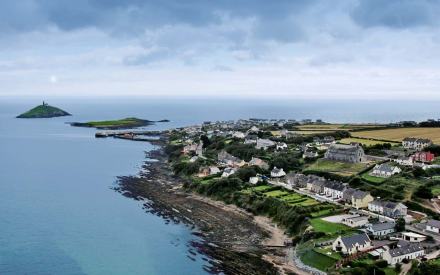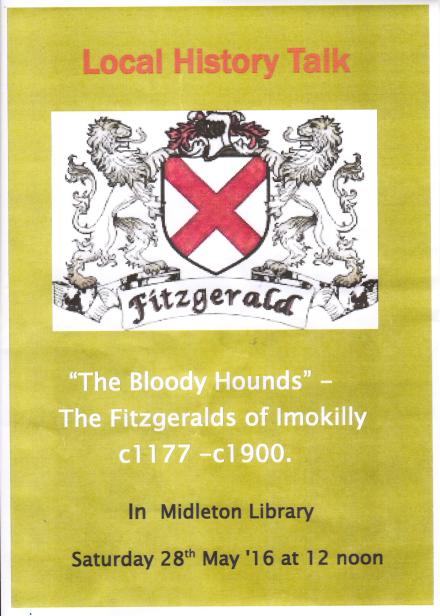
Ballycotton on its headland, with its two islands and tiny harbour for fishermen.
The fishing village of Ballycotton in East Cork is perched on a cliff with a headland providing modest protection for its tiny harbour. The modern village is apparently bereft of any buildings older than the early 19th century. Yet the site was settled for centuries. The village was certainly there before 1364 when the tenants were recorded in the Pipe Roll of Cloyne (Rotulus Pipae Clonensis), the most valuable account of the manors and estates of the Bishop of Cloyne to survive to the present day. Sadly, the original Pipe Roll was destroyed in the burning of the Public Record Office in Dublin in 1922. Fortunately for us, a Cork historian and antiquarian, Richard Caulfield, published the entire document in 1859. However, there were errors in that publication, probably the fault of the printer rather than of Caulfield himself. In 1996, the Cloyne Literary and Historical Society published a new edition, based on Caulfield’s original. but not content with simply republishing the original, the Society worked with two excellent editors, Paul MacCotter and Kenneth Nicholls, to produce a wonderful edition consisting of the original Latin text on one page, with the English translation on the facing page, and an enormous, and priceless, collection of Endnotes and Commentary taking up half the volume.
To illustrate the richness of the Pipe Roll as a record of mediaeval East Cork, in this post I am going to present the names of those who rented land from the Bishop of Cloyne at Ballycotton barely two decades after the Black Death had decimated the population of Ireland and Europe.
The name of the settlement given in the document was Balycottyn but other mediaeval spellings included Balycotekyn (1260), Balycocekyn (1275-76), probably derived from the Irish Baile Coitchinn – ‘common town’ since it was inhabited by common folk rather than clerics or gentlemen.
Ballycotton is described as consisting of two ploughlands of arable land, six acres of meadow land, thirty acres of turbary (peat bog), forty acres of moor and pasture, and sixty acres of underwood (scrubland).
The Bishop kept in hand one and a half ploughlands, six and a half acres of meadow, thirty acres of turf bog, forty acres of moorland, and the sixty acres of scrubland. Ballycotton was part of the Manor of Cloyne – one of several manors that belonged to the Bishop of Cloyne. There was no record of a church there and it should be noted that the village was always part of the parish of Cloyne. The inhabitants were mostly tied to the manor in 1364 – that is they were serfs or villeins who had no access to the King’s courts of law.
Gilbert Walys (Walsh)* held 56 ‘acres as they lie’ in betaghry (serfdom). That is his land was measured by custom rather than by a precise survey. Gilbert owed 37s 4d in annual rent. He also paid 2s 4d annually on the feast of St Peter in Chains (1st August) for reaping the Bishop’s corn.
The same Gilbert Walys also held a second small parcel of land nearby at a rent of 3s 1d and 4d for reaping.
The 20 acres of land formerly held by William O’Longhan was now held by unnamed occupiers for 13s 4d and 10d for reaping.
The 15 acres formerly held by William Goygh were rented to the occupiers for 10s and 7 12 d for reaping.
Laurence O’Longhan held 14 acres in betaghry for 9s 4d annually and 7d for reaping.
The son of Laurence Codd held in fee farm (perpetual lease) fourteen acres besides his own holding at 13s 8d. He ploughed an acre in two days in spring for the Bishop and and also weeded the Bishop’s corn for two days in autumn. He was not permitted to interfere with the moor which lay beside his own moor.
Then comes a list of cottagers:
Richard Pussagh paid 6d annually for his cottage, Geoffrey Codd paid 12d, Thomas O’Duyr paid 6d, O’Lorkan paid 6d, as did Luke Lowys, Philip Barry, Adam Gogh, David O’Bryn, and David O’Fyn. John O’Kynel (O’Kineally) paid 3d for his cottage. It seems that all of these cottages had gardens attached to supply additional foodstuffs.
In addition to the rent all of these people in the cottages were fishermen – it is likely that those with larger holdings were also fishermen. They had to sell fish to the Bishop at a discount – he could take fish worth 12d for just 8d.. In season they had to sell a ling to the Bishop for just 2d, a cod for one and a half pence, three haddocks for 1d. However, the Bishop was not entitled to take more fish than he actually required for his household.
Further obligations the Bishop’s tenants had to render to the lord of the manor included making turning and gathering the Bishop’s hay, they had to week the Bishop’s corn, and make the Bishop’s turf. Failing that they had to pay the bishop 3d. For every cow they possessed they paid the Bishop 3d, and if they had sheep, six sheep were counted as a single cow.
One final obligation was imposed on the tenants at Ballycotton – each man had to present the Bishop with a hen at Christmas.
As a document the Pipe Roll of Cloyne gives a wonderful insight into the lives of the tenants not just of Ballycotton but of all the Bishop’s estates in the fourteenth century.
*Correction: I had previously put the name Walys down as Wallace/Wallis. This was incorrect. The name is actually Walsh – a common name in East Cork.
(Source: Paul MacCotter and Kenneth Nicholls, editors: The Pipe Roll of Cloyne – Rotulus Pipae Clonensis. Cloyne Literary and Historical Society, 1996.)

